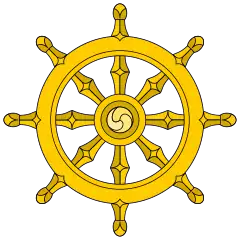Amitabha Pure Land Rebirth Mantra
The Amitabha Pure Land Rebirth Mantra is considered an important mantra or dharani in Pure Land Buddhism and other schools of Buddhism, mainly following the Mahayana tradition. The full name of this mantra is the Dharani for pulling out the fundamental cause of karmic obstacles and obtaining rebirth in the Pure Lands (Chinese:拔一切業障根本得生淨土陀羅尼). It is also known as Pure Land Rebirth Dhāraṇī (Chinese:往生淨土神咒; Wang Sheng Jing Tu Shen Zhou), or Rebirth Mantra (Chinese: 往生咒; Wang Sheng Zhou) for short.
| Part of a series on |
| Buddhism |
|---|
 |
|
Reciting this mantra grants the reciter a peaceful and joyful life in this life, and allow them to be reborn into the Western Pure Land of Ultimate Bliss in the future. It can also be recited to help the spirits of the animals that a person has killed in the past, including poultry, game, aquatic creatures, insects, etc. to ascend to a higher spiritual realm.[1]
Background
The mantra was translated from Sanskrit into Chinese by Guṇabhadra (Sanskrit; Chinese: 求那跋陀羅, 394-468) from central India. It is usually recited 21, 27 or 49 times per day.[2] In one type of group practice, participants usually recite this mantra three times after reciting the Heart Sutra or the Amitabha Sutra.
The word "rebirth" tends to make people think that this mantra is only about "being reborn", and that it can only serve the particular purpose of going to the Pure Land. However, another positive and important function and meaning of this mantra is the "pulling out the fundamental cause of karmic obstacles". It brings about benefits for the reciter in this present life.[3]
Text of the mantra
- namo amitābhāya tathāgatāya
- tadyathā
- amṛtod-bhave
- amṛta-siddhaṃ bhave
- amṛta-vikrānte
- amṛta-vikrānta
- gāmine gagana
- kīrta-kare svāhā
See also
References
- The Daily Recitation Handbook: Sagely City of Ten Thousand Buddhas (English and Chinese ed.). Buddhist Text Translation Society. 2002. ISBN 978-0881398571.
- Lu, Jun Hong (March 2012). Buddhism : your questions answered : frequently asked questions about practising Buddhism (First ed.). Sydney NSW. ISBN 978-0-9872230-5-0. OCLC 1047728511.
- Lin, Guangming (fo jiao); 林光明 (佛教) (2000[min 89]). Ren shi zhou yu. 林光明, 1949- (Chu ban ed.). Tai bei shi: Fa gu wen hua. ISBN 957-598-141-3. OCLC 816249927. Check date values in:
|date=(help)